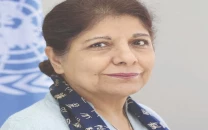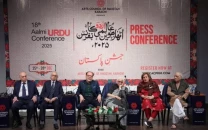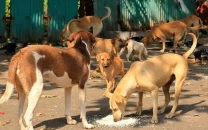Last of the Macedonians: Kalasha Dur saving the lost sons of Alexander
The museum in Bumburet struggles to preserve Kalasha culture in the face of rising extremism.

A flash of black robes, blonde hair under an orange headdress and curious blue eyes have welcomed visitors to the hidden valleys of Kalash for centuries. Pakistan has been described as a melting pot of cultures by many, but nowhere does this become as apparent as when one takes the dilapidated road into Bumburet Valley.
Living in a world unto themselves, there have been many speculations as to the origins of the Kalasha. One of the most widely accepted theories, however, links them directly to the Greek armies of Alexander the Great.
The mighty Macedonian swept everything between Pella and the Indian subcontinent in the 4th century BC at the head of a seemingly unstoppable army. Alexander founded various settlements on his warpath as well – most of which were named after him – but whether he left behind this animistic society of Kalash has been long debated. Interestingly, a February 2014 article by the New York Times on tracing ancestries claimed to have established the link. Quoting well-reputed geneticists, the Kalasha were said to have ‘chunks of DNA from an ancient European population’. It added that this came about as the result of a ‘mixing event’ at some point in time between 990 BC and 210 BC.
A Dardic population in a region of overwhelmingly Indo-Aryan stock, the cultural distinctiveness of the Kalasha is glaringly obvious to any visitor. As a result of this, they have also become an obvious target in the face of rising extremism in the wider region. While some have dispelled the seriousness of the matter, many continue to think that a grave threat is being posed to the Kalasha’s ancient way of life.
It was a decade ago that an organisation called Kalash Welfare established the only museum in the region with the assistance of the Greek government. Kalasha Dur – meaning ‘house of the people’ in Kalashamondr – is one of the few institutions aiming to preserve the culture, history, arts and crafts of one of the last remaining Shaman societies on earth.
The museum, built in Bumburet, falls under the supervision of the Khyber-Pakhtunkhwa (K-P) government’s Directorate of Archaeology and Museums. However, it is administered by a committee comprised of local residents, most of whom work on a volunteer basis.
The property covers about 4 kanals of land and has been constructed with an intricate balance of traditional design and modern methods. The concrete skeleton is layered with stone walls, parallel wooden beams and carved verandas that are characteristic of the region and have long been a feature of houses, temples and altars in the valley. Near the front entrance of the museum has also been built a temple dedicated to the deity Jestak, the protector of generations in local traditions.
Kalasha Dur houses a large number of ethnological collections of Kalasha culture and the wider Hindu Kush range. Hand-woven costumes, leather pouches, antique jewellery, wooden statues, an unsettling variety of weapons, baskets used to transport crops, weaving equipment, household utensils, musical instruments, carved columns and doors are found in abundance at the museum and in a surprisingly well-preserved state.
The second floor of the building houses a school of Kalasha culture with a library of books written on the valley, and also a hall for professional training of local crafts.
A member of the administrative committee, Saeed Saftali, told The Express Tribune that most of the artefacts have been purchased, while others have been donated by people from all three valleys: Bumburet, Birir and Rumbur.
“Some antiques have also been purchased from markets as far as Chitral and Peshawar,” said Saftali, adding that everyday dozens of people from around the globe would once visit Kalasha Dur. “However, the arrival of international tourists has almost stopped now.”
One of the first Kalasha archaeologists, who also worked as a gallery assistant at the museum, Sayed Gul Kalash informed that the K-P government is working to construct another museum in Bumburet.
“These steps are necessary for the preservation of our traditions and history,” said the archaeologist.
“The Kalasha culture has been around for thousands of years and will remain alive for thousands more to come.”
Published in The Express Tribune, June 29th, 2014.



















COMMENTS
Comments are moderated and generally will be posted if they are on-topic and not abusive.
For more information, please see our Comments FAQ